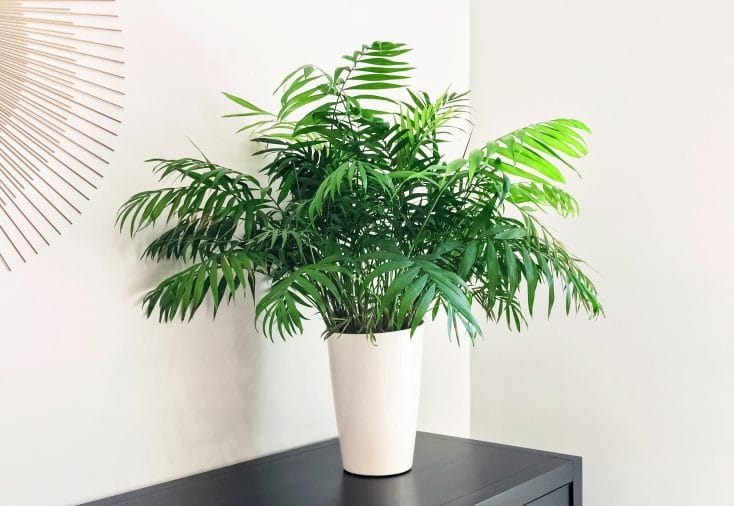Bringing the tropics indoors has never been easier than with the addition of a Parlor Palm (Chamaedorea elegans). Where many types of palms don’t grow well indoors, Parlor Palms thrive and are considered low-maintenance and hardy houseplants. Below is a quick summary of their care.
How To Care For A Parlor Palm: To keep your Parlor Palm healthy and thriving, grow in rich, well-drained soil and water when the top several inches become dry. Create above average humidity, fertilize every three to four weeks, maintain indoor temperatures of 65°F to 80°F and situate in bright, indirect light.
Continue reading because we’ve taken all the mystery out of growing a Parlor Palm indoors and having it perform as a healthy and happy houseplant for many years.
How To Care For A Parlor Palm
Parlor Palms, also known by the common names Neanthe Bella palm and Neanthe palm, are members of the Arecaceae family. Their native range is the dense rainforests of Guatemala and southern Mexico where the environment is consistently warm and humid.
The palms have been popular indoor plants since Victorian times and today, still hold their popularity. Besides inside the home, you can often see these attractive palms growing in office buildings, schools and shopping centers.
These are handsome, lush palms and it is easy to see why they are so popular. Parlor Palms have dense, deep green, feathery foliage born on arching branches. They usually develop bamboo-like ridges along the trunk as it ages.
In fact, if you are looking for a plant resembling bamboo, then a Parlor Palm is the right choice for you. You usually find larger specimens of the palm planted with three plants per container.
If given an adequate amount of light, which doesn’t always happen indoors, Parlor Palms produce clusters of yellow flowers in springtime. Dark, black berries follow the flowers. If your palm fails to bloom while growing indoors, do not stress. This is normal based on typical growing conditions inside the home.
When grown outdoors in its preferred environment, a Parlor Palm can grow up to 8 feet tall. However, when grown indoors as a houseplant, it typically grows to a mature height of around 4 feet.
They have a slow rate of growth, so no need to worry about them quickly outgrowing their pots. These palms are only hardy growing outdoors in climates that do not experience frosts or freezing temperatures.
Since they make such hardy and outstanding indoor plants, those living in more temperature climates can still grace their indoor spaces with one or even two.
If you’d like to feel like you are visiting a tropical paradise year-round and desire an easy to care for plant, then adding a Parlor Palm indoors will fulfill this need. Provided proper care and growing conditions, these aren’t fussy plants and even the novice gardener will have success growing them.
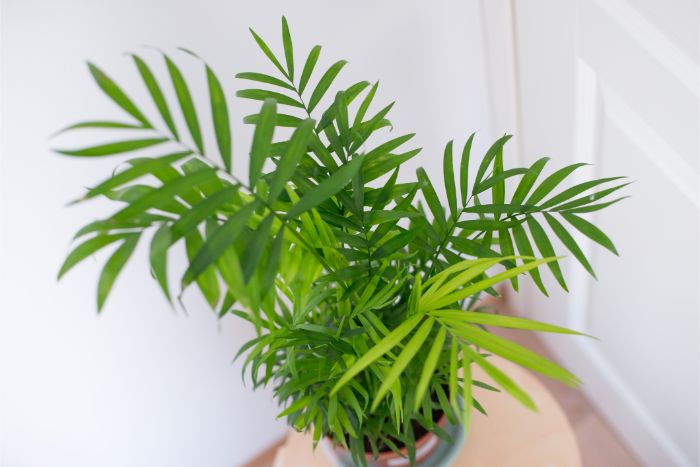
Soil Conditions For Parlor Palms
For the best growth and performance, grow your Parlor Palm in a rich potting medium that drains well. If the soil is too heavy and has a tendency to retain too much water you can end up with rot problems and may even lose the palm.
Using a peat-based potting mix works well, as does most commercial, pre-mixed potting mixes. Many times, straight potting soils have a tendency to be too heavy, but you can use them as long as you cut them with another ingredient that has good drainage.
Some types of pre-mixed potting mixes have a slow-release fertilizer incorporated into them, which means you don’t have to feed the palm as frequently, as the product usually continues feeding for around three months.
You can also create your own potting mix for the palm. Any of the following will work well:
- Mix one part potting soil, one part coarse sand
- Mix one part peat, one part coarse sand, one part potting soil
- Mix one part compost, one part peat, one part perlite
The most important factor to remember when it comes to the proper soil is to make sure it drains properly when watered. If the water remains on top of the soil, it is probably too heavy of a mix and needs to be lightened up.
How Much Light Do Parlor Palms Need?
One of the great attributes of the Parlor Palm is its ability to thrive in lower light conditions and artificial lighting. It keeps growing without skipping a beat in a lower light setting, where many indoor plants will fail to thrive.
However, for the best growth and performance, place the palm in a location that receives bright, indirect light.
If you desire to give your palm a bit of a break from indoor growth, once the weather warms in spring you can set it outdoors. Just be sure not to place it in a location that receives direct sunlight or the leaves can scorch.
It will perform best situated in a shady location out of the direct rays of the sun. In addition, remember to bring the plant back indoors before the cold winds of fall and winter arrive on the scene.
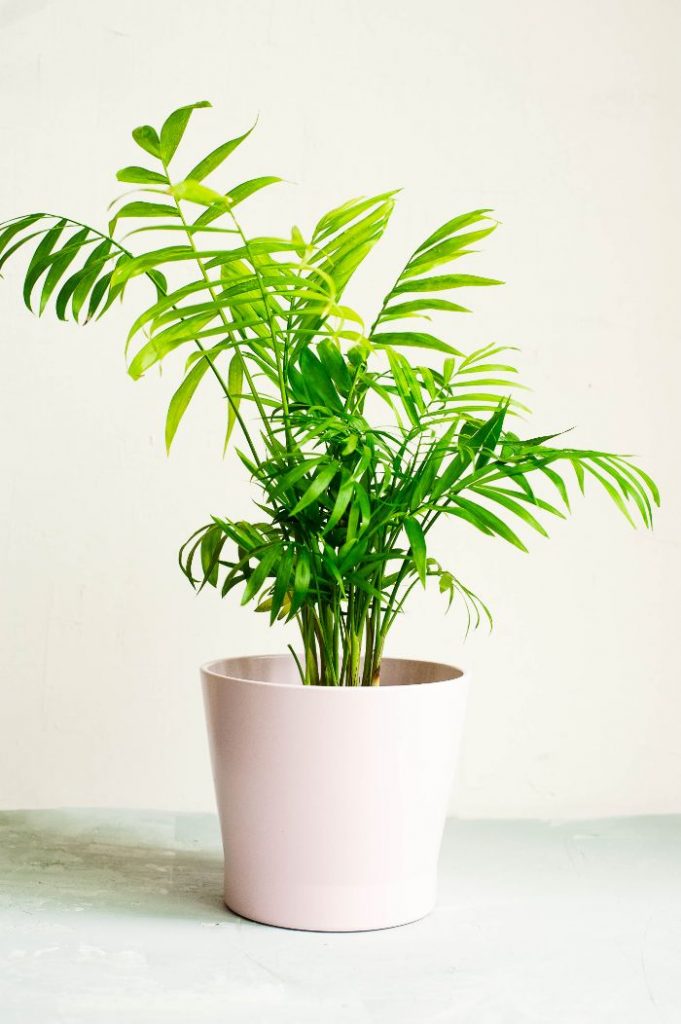
Indoor Temperature Requirements
Since the Parlor Palm is native to regions that are consistently warm, it will grow best when indoor temperatures between 65°F and 80°F are maintained. Generally, if you are comfortable inside the home, your Parlor palm will be comfortable too.
If your outdoor location has a tendency to have cold winter temperatures, don’t situate the Parlor Palm by a window or door where the cold temperature leaks inside. Move the palm to an indoor location with similar lighting until the outdoor conditions warm.
How To Water Parlor Palm
Parlor palms have a moderate tolerance to drought conditions and are more forgiving if you forget to water than if you overdo the watering and water too frequently. Watering too often allows the soil to remain soggy for too long, which then promotes problems with rot. If rot develops, you can end up losing your palm tree.
During the growing season of spring throughout summer, you will typically have to water once each week. However, during winter while the Parlor Palm is dormant and its growth slows, it will probably only require an application of water every couple of weeks.
You can easily check the soil to see if it is time to water and this will alleviate problems with overwatering. Stick your finger into the potting mix and if the top several inches of soil feel dry to the touch, apply water until it runs out of the container’s bottom drain holes.
See my other articles to master the difficult skill of watering indoor plants properly.
- 8 Ways To Tell When A Houseplant Needs Water
- How Often Should You Water Houseplants?
- What’s The Best Time Of Day To Water Plants?
When it comes to the appropriate water to use:
- Do not use cold water and instead, use room temperature water.
- If your water contains chemicals, allow it to sit out overnight before using.
- It is fine to water using rainwater or distilled water.
Humidity Requirements
In the Parlor Palm’s native environment of densely forested rainforests, the humidity levels are high and constant. Therefore, it goes to reason for your Parlor Palm to perform and look its best these conditions needs to be replicated inside the home, which is easy. If humidity is too low it can cause the palm to develop brown tips on the fronds.
Doing any of the following will create adequate amounts of humidity for your Parlor Palm:
- Use a humidifier to increase humidity levels for your Parlor Palm.
- Set the container on a tray of pebbles. As you water, the fluid drains from the bottom of the pot’s holes and into the pebble-lined tray and as it evaporates, it creates humidity around the plant.
- If your bathroom has enough light and is large enough, depending on the size of your Parlor palm, you can grow the plant there. Due to the constant use of water inside the room, adequate humidity is created for the palm.
If the spirit moves you to spritz the Parlor palm with water daily, don’t worry because Parlor Palms are very tolerant of this. An additional benefit of spraying the palm’s leaves with water is it assists in washing off any dust particles developing on them. You will be benefiting the palm in two ways by giving it periodic sprays of water and keeping those deep green leaves shiny and healthy looking.
In addition, and especially during winter when you have the heater going inside the home, don’t situate the Parlor Palm close to a heating vent producing dry air, which prevents humidity from forming. If needed, move the palm to an indoor location away from the drying vent that has similar lighting.
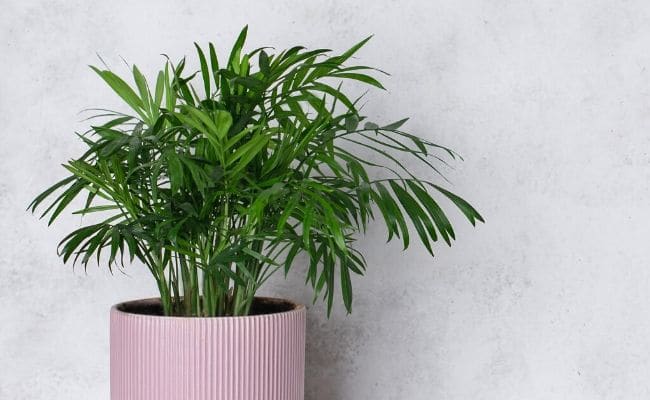
Fertilizer Needs
Besides growing the Parlor Palm in a fertile soil mixture, which continuously feeds the plant’s roots with nutrients, it is important to fertilize regularly. If you planted it in a potting mix that contained a slow-release fertilizer blend, then you will not have to worry about additional feedings for about three months.
These type of fertilizers degrade slowly in the soil and continue feeding the palm with each water application. Depending on the particular brand, they usually don’t require a new application for around three months.
To keep the Parlor Palm thriving with healthy growth, fertilize about every three to four weeks with a water-soluble blend for houseplants. Just mix the product in the container you use for watering and apply with its regular water application.
If you prefer to use a slow-release blend, just apply fresh granules about three months after planting, if you originally planted in a potting mix containing the product. If not, just spread the granules over the container’s soil and water in well. Reapply in about three months or per the particular product’s instructions.
Only fertilize the Parlor Palm during the growing season of spring throughout summer. The palm is actively growing during this time of year. During winter while the palm is dormant, cease all fertilization until the warm temperatures of spring arrive.
Fertilizers can buildup in the soil after months of their use. Too much nutrient salts in the soil can burn the Parlor Palm’s foliage, so you will need to flush the soil periodically with fresh water to remove the salts. The process of flushing the soil is relatively easy:
- For smaller Parlor Palms, take the container to the sink and allow a slow stream of water to run through the soil for about five minutes. Allow the container to drain before placing back in its preferred location.
- If your Parlor Palm is too large for the sink, take it to bathtub or outdoors by the hose and flush the soil with a slow stream of water for about five minutes. Once drained, bring the palm back to its desired location indoors.
Pruning Requirements
When it comes to pruning requirements for your Parlor Palm, they are very low. Like many types of palm trees, Parlor Palms are self-cleaning, meaning the old fronds naturally turn completely brown and drop from the plant without assistance.
However, you can snip off the end of leaves if the tips are discolored, dead or suffering problems. Make sure to use clean pruning blades when making your cuts so you do not transfer any disease or pests to the palm. Just wipe the blades off with rubbing alcohol and you’re ready to start trimming.
Although naturally browning palm fronds can be unsightly on a houseplant, it’s best to allow the frond to die naturally and not prune it off while it still contains green.
All types of palm trees continue receiving nutrients from a palm frond that contains even a little green. Therefore, don’t trim off numerous amounts of green fronds or you will be robbing the palm of much needed nutrients.
Potting Needs
When it comes to the sizes of Parlor Palms that are readily available, you can find them on the smaller size growing in 2- to 4-inch pots, all the way to large, fully-grown specimens growing in 5-gallon containers or larger.
Since Parlor palms are slow growing and unless the roots have completely filled its present container, you won’t have to worry about repotting for quite some time. Of course, those growing in the smallest containers will require repotting sooner than those grown in larger containers with more soil space.
If you do need to repot your Parlor Palm, just use a container that is one size larger. You don’t want to use a container that is too large because the soil has a tendency to take longer to dry from wet conditions, which can lead to rot problems in your palm.
Any material of pot works well provided there are holes in its bottom for drainage. However, those made of a porous material like terra cotta will help the soil dry out faster than the soil in pots made of plastic.
If you place the inner pot inside of a more decorative one with a solid bottom, make sure to empty out any water that accumulates in its bottom after you water. Once again, pots that do not drain causing standing water in their bottom leads to potential problems with root rot.
Repotting your Parlor Palm is relatively basic:
- Fill an appropriately sized pot with bottom drain holes about 1/3 full of a fertile, well-drained potting mix. Water the soil to settle it.
- Remove the Parlor Palm from its present container and inspect the root system for wrapping. If the roots are starting to wrap in a circle or bunch tightly together, gently tease them apart with your fingers.
- Place the Parlor Palm into its new pot and fill the remainder with soil, being sure to not plant any deeper than it was growing in its original pot. Planting too deep puts undo stress on the palm. Firm the soil up around the Parlor Palm’s base.
- Water the Parlor Palm until it drains from the bottom of the pot and water again when the top several inches of soil dry. Situate the palm in a preferred location inside the home.
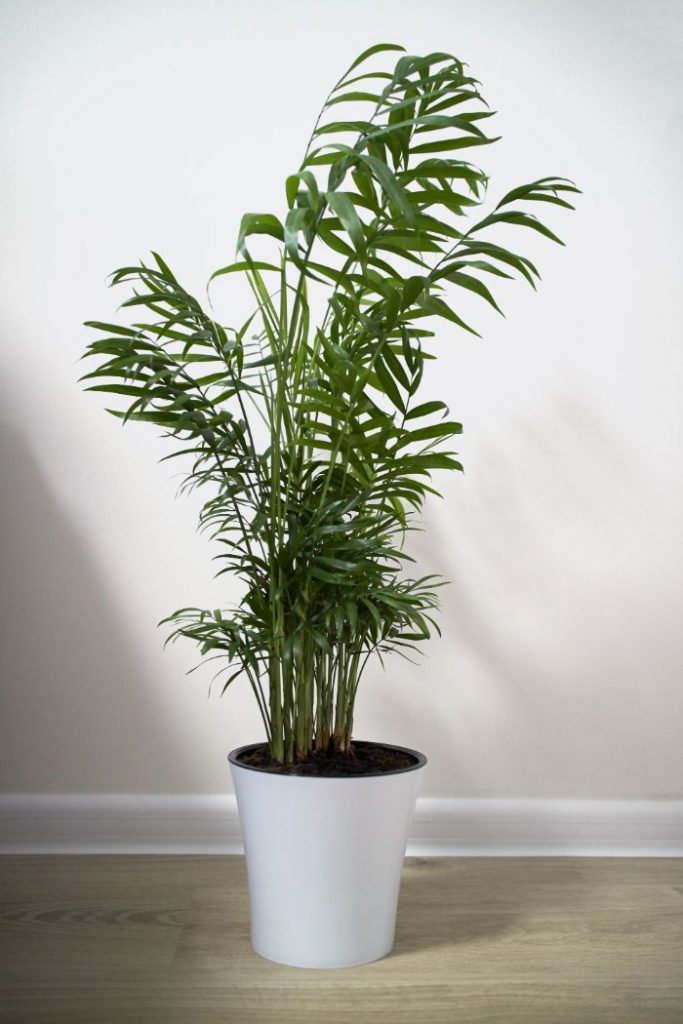
Parlor Palm Propagation
Propagating Parlor Palms is done through growing seeds. However, due to indoor light conditions not being adequate for a Parlor palm to bloom, which then results in the formation of small, black seeds, don’t be surprised if yours never goes through the blooming or seed-bearing stage while as a houseplant.
Many online seed dealers handling tropical plants and palms do offer the seeds for sale. When it comes to propagating Parlor Palm seed, the fresher the seeds the greater chance you have of germination. If you do find a source for these palm seeds you might want to try planting several seeds to increase the possibility of some of them germinating.
The process for planting and germinating Parlor Palm seeds is basic and you will have the most success when outdoor temperatures are warm, unless you use a heat mat for indoor germination:
- Fill a seed-starting tray or small, 4-inch containers with a lightweight, well-drained potting mix. Make sure the containers have bottom drainage. Water the soil to settle it.
- Plant a Parlor Palm seed about 1/4 inch deep into the soil and cover with the potting mix. If planting multiple seeds in a tray, space the seeds several inches apart. Water the soil again.
- If starting the Parlor Palm seeds outdoors, place in the warmest area of your outside space. Seed germination is best when temperatures range between 85°F to 95°F.
- If starting the seeds indoors, place the trays on a heat mat set at around 85°F.
- Keep the potting mix moist but not soggy. If the top of the soil feels dry, water.
Like many types of palms, it can take several months for viable Parlor palm seeds to germinate.
Disease Problems
When grown in proper conditions, Parlor Palms aren’t plagued by any serious diseases. However, overwatering is the palm’s biggest enemy, which leads to problems with root rot that can eventually kill the entire palm.
The problem usually rears its ugly head by what should be healthy fronds completely browning and sections of the trunk browning and beginning to soften and rot. In severe cases, the root system turns mushy and rots.
Prevent problems with rot by:
- Watering only when the top several inches of soil become dry.
- Growing the Parlor Palm in lightweight soil that drains well and doesn’t remain soggy.
- Making sure the container has bottom drain holes.
If you notice the beginnings of a potential problem, stop watering and allow the soil to completely dry before watering again. If the potting medium is too heavy and remains soggy for too long, you should repot the Parlor Palm using another potting mix that is lighter and drains well. Trim off any affected sections of roots.
Pest Problems
Like many indoor plants, the biggest pest threats to the Parlor Palm are mealybugs and spider mites. Fortunately, both are easily recognizable and you will want to treat a problem quickly so the pesky pests don’t travel to your other houseplants.
- Spider mites: The tiny pest covers the Parlor Palm’s leaves in a fine webbing, much like a spider would. Spider mites suck juices from the leaves and if left untreated, the foliage loses its color and in an extremely bad infestation, can kill the palm, especially if it’s small.
- Mealybugs: Mealybugs form mass groupings on the Parlor Palm’s leaves or their crotches that resemble cotton. Like spider mites, mealybugs suck the plant’s juices, leaving foliage discolored. The smaller the palm, the more damage the pest causes.
Safe options for treating both pests include:
- In small infestations, wipe the affected foliage off with a clean, damp cloth.
- Saturate both sides of the foliage and plant with an insecticidal soap or Neem, mixing and reapplying as suggested on the product label.
For more information about getting rid of houseplant bugs naturally, see my article on this topic.
Why Are The Leaf Tips On My Parlor Palm Turning Brown?
There are several reasons your Parlor Palm’s leaf tips are turning brown. As a palm frond naturally starts dying, the leaf tips brown and the browning eventually covers the entire frond to where it’s attached to the trunk. This is a normal occurrence and the frond will naturally fall from the trunk or you can prune it off after it browns completely.
The other reasons for brown tips include overwatering causing rot, or too much soluble salts in the soil due to fertilizers. Many times in a palm, the roots are already starting to suffer damage from wet conditions before it shows on the foliage.
If fertilization isn’t the problem and the soil is too soggy, stop watering and allow the soil to completely dry before you water again. If the soil is too heavy, you will need to repot the Parlor Palm into a more lightweight potting mix. Just check the roots to make sure they aren’t turning mushy from rot. If several are damaged you can trim them off, but if large sections are affected, the Parlor palm might die.
If you aren’t overwatering but applying fertilizer, you probably need to flush the salt buildup from the soil. Allow a slow stream of water to run through the soil for about five minutes and then allow it to drain. Only fertilize the Parlor palm every three to four weeks using a water-soluble blend for houseplants and flush the soil about every four months.
Why Are My Parlor Palm’s Leaves Turning Yellow?
Yellowing leaves on a Parlor Palm is usually a sign the palm isn’t getting enough water. Although they do not like to sit in soggy conditions, they still require regular water applications for the fronds to look their best.
During the growing season of spring through summer, you will probably water once weekly. In winter while the palm is dormant, you will probably only have to water every few weeks.
An easy way to check is by sticking your finger into the soil and if the top several inches are dry, apply water until it runs from the bottom drain holes.
Does A Parlor Palm Bloom?
It can take quite a few years of growing before a Parlor Palm starts producing flowers. However, when grown indoors where light conditions aren’t always adequate for the production of flowers, the palm may never bloom. When grown outdoors in ideal conditions, it produces sprays of small, yellow flowers during summer that change to small and round black fruits containing seeds.
Do Parlor Palms Need Sunlight?
One of the things that make Parlor Palms such great houseplants is the fact they can thrive grown under artificial and lower light conditions. In fact, don’t place it in an outdoor or indoor location that receives bright, direct sunlight or the leaves will burn. A location receiving bright, indirect light is best.
How Tall Do Parlor Palms Get?
Parlor Palms grown indoors typically top out at 4 feet tall, but when grown outdoors in a preferred environment, the palm can reach 8 feet tall at maturity.
Are Parlor Palms Toxic To Cats?
Parlor palms are considered non-toxic to cats, dogs and people.
Does A Parlor Palm Produce Seeds?
Although indoor palms rarely bloom to produce fruit, in its preferred environment the palm produces yellow flowers that turn into small black fruits that contain a seed per fruit.

